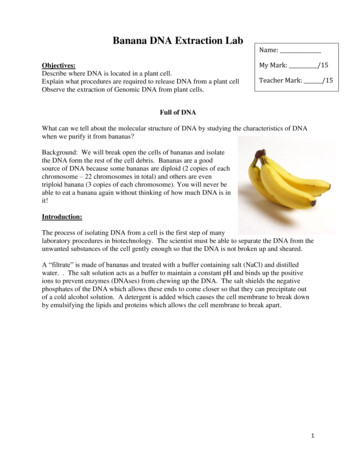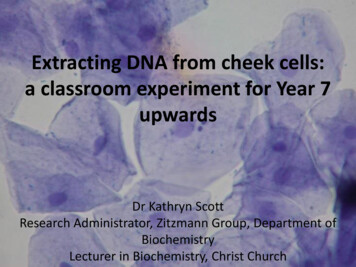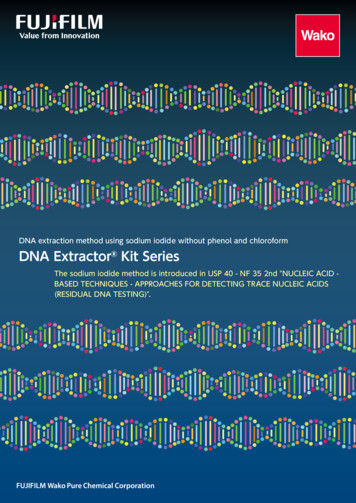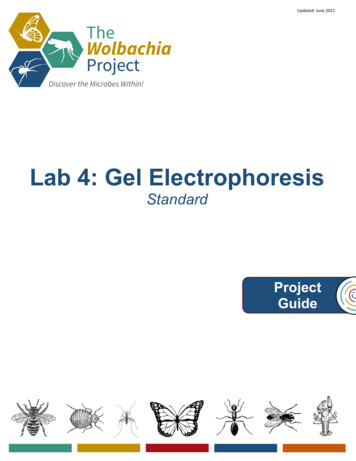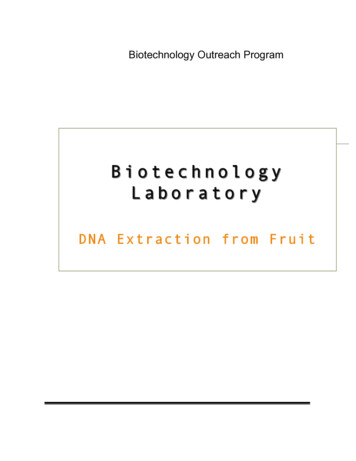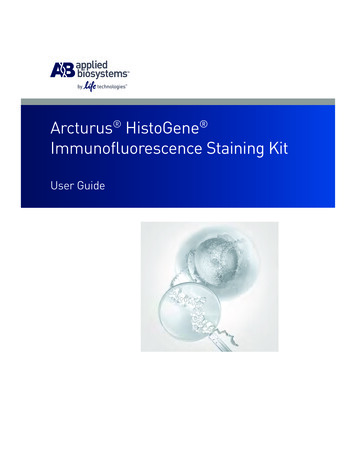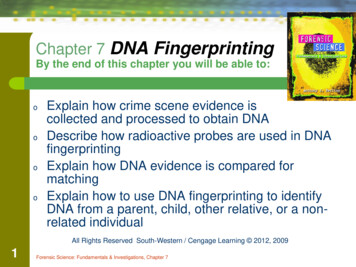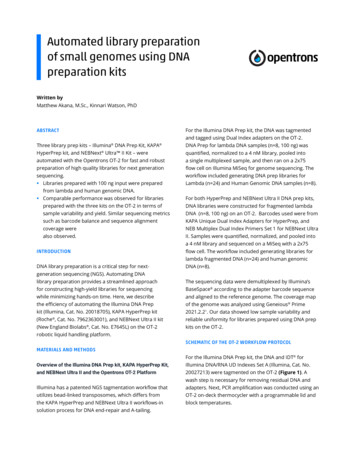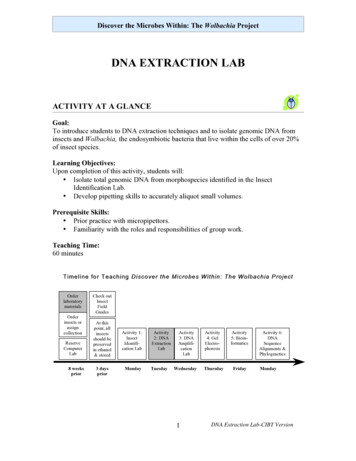
Transcription
Discover the Microbes Within: The Wolbachia ProjectDNA EXTRACTION LABACTIVITY AT A GLANCEGoal:To introduce students to DNA extraction techniques and to isolate genomic DNA frominsects and Wolbachia, the endosymbiotic bacteria that live within the cells of over 20%of insect species.Learning Objectives:Upon completion of this activity, students will: Isolate total genomic DNA from morphospecies identified in the InsectIdentification Lab. Develop pipetting skills to accurately aliquot small volumes.Prerequisite Skills: Prior practice with micropipettors. Familiarity with the roles and responsibilities of group work.Teaching Time:60 minutesTimeline for Teaching Di scover the Microbes W ithin: The W olbachia ProjectOrderlaboratorymaterialsOrderinsects orassigncollectionReserveComputerLab8 weekspriorCheck outInsectFieldGuidesAt thispoint, allinsectsshould bepreservedin ethanol& storedin labfreezer3 dayspriorActivity 1:InsectIdentification LabMondayActivity2: DNAExtractionLabTuesdayActivity3: DNAAmplificationLabActivity4: GelElectrophoresisActivity5: BioinformaticsWednesdayThursdayFriday1Activity 6:DNASequenceAlignments &PhylogeneticsMondayDNA Extraction Lab-CIBT Version
Discover the Microbes Within: The Wolbachia ProjectOVERVIEWIn this activity, students will extract total genomic DNA from each of their threemorphospecies using Qiagen’s DNeasy Tissue Culture Kit. Total genomic DNA includesDNA of the insect host as well as any symbiotic bacteria, if present. In addition to the 3unknown morphospecies, students will also prepare positive and negative controls usingNasonia vitripennis wasps that are infected and uninfected with Wolbachia pipientis,respectively. The Nasonia controls may be obtained by contacting Dr. Seth Bordensteinat The Marine Biological Laboratory (sbordenstein@mbl.edu) at least three weeks priorto beginning the lab series.The extraction of total genomic DNA involves three distinct steps:1. Cell Lysis: Students will begin by washing their insect specimens inphosphate buffered saline (PBS) and then macerating them in a cell lysissolution (Buffer AL). This basically breaks open cell and nuclearmembranes. The dilemma here is that it also exposes DNA to proteins andhydrolytic enzymes in the insect tissue that may degrade the DNA.Therefore, the enzyme Proteinase K must be added to denature the proteinsand keep the DNA intact. Finally, they will add ethanol to precipitate theDNA.2. Elimination of Cellular Debris: Once students have destroyed thehydrolytic enzymes and precipitated DNA, they will begin the DNApurification process. In essence they will place the cellular components,including DNA, into a spin column and wash the spin column of allcomponents except DNA. Upon centrifugation the material will passthrough the filter, which attracts DNA and allows debris to pass through.This will be followed by two wash steps with two buffers (AW1 and AW2).3. DNA Elution: Students will complete the activity by removing the DNAfrom the filter. This is done by adding the elution buffer (AE). Spinning thetube with the DNA embedded in the filter will pull the elution bufferthrough the matrix, thus pulling the DNA into the collection tube.2DNA Extraction Lab-CIBT Version
Discover the Microbes Within: The Wolbachia ProjectMATERIALSq q q q q Heat block @ 70ºC*Vortexer (optional)Student morphospecies and – Nasonia controls*Microtube pestles (one perinsect sample)* (USA Scientific 1415-q q q q 5390)q q q q q q Qiagen DNeasy Kit*P200 & P1000 pipets*P200 & P1000 pipet tips*Small glass beakers (forEtOH)Waste cups for tips, etc.q q q q Microcentrifuge*Gloves1X Phosphate Buffer Saline*(10X PBS from Fisher BP399-500 and diluteto 1X)SharpiesTweezersKimwipes or paper towelsEthanol (95 - 100%)Tube racks* (USA Scientific 2396-5048)1.5ml microcentrifuge tubes(USA Scientific 1415-9199)**provided with CIBT kitTEACHER PREPARATIONThis lab requires attention to detail, but it's worth it. Aliquot all of your reagents ahead oftime into labeled sets of tubes so that YOU don’t get confused. Use the P1000 and P200pipettes to aliquot the solutions into individual tubes for your students. Each student willbe preparing two DNA extracts, one from their collected insect, and one from either apositive or negative control Nasonia. Each group of two students will therefore be doingfour DNA extractions (two unknown DNA samples, one Nasonia control, and one –Nasonia control). Students will use sterile transfer pipettes to add the aliquotted solutionsto their DNA extractions. Make sure you hand out 4 differently colored microtube pestlesper student group to minimize the risk of contamination between samples. You shouldalso hand out small glass beakers (one per group of 4 students) with ethanol for thestudents to rinse their tweezers in between different samples.3DNA Extraction Lab-CIBT Version
Discover the Microbes Within: The Wolbachia ProjectReagents# of tubesneededfor 16 students# of tubesneededAmount neededfor each team ofper tube2 studentsPipette used toaliquotPBS324180 µlP200Proteinase K32420 µlP200Buffer AL324200 µlP200Ethanol (95 100%)324200 µlP200Buffer AW1324500 µlP1000Buffer AW2324500 µlP1000Buffer AE324100 µlP200ACTIVITY PROCEDUREReview the activity flow-chart (page 10) with your class and instruct them to revisit theirhypothesis from the Insect Identification Lab Mini-Report. Students will work with theirsame partners from Lab 1 and follow the protocol outlined on the student sheet. They areencouraged to read through the procedure prior to beginning the activity in order toidentify and understand the purpose of each reagent. Answers are shown below: Phosphate Buffered Saline (PBS): a salty solution of constant pH to keep tissues,cells, and proteins intact during maceration Proteinase K: an enzyme that catalyzes the breakdown of cellular proteins bysplitting them into smaller peptides and amino acids Buffer AL: a cell lysis solution that breaks open cell and nuclear membranes Ethanol: used to precipitate DNA from the extracted material4DNA Extraction Lab-CIBT Version
Discover the Microbes Within: The Wolbachia Project Buffer AW1 and AW2: solutions that wash the DNA attached in the columnmembrane of contaminants Buffer AE: a solution that elutes the DNA from the membrane and allows stablestorage of DNA for years in the refrigerator or freezer5DNA Extraction Lab-CIBT Version
Discover the Microbes Within: The Wolbachia ProjectStudent Activity SheetName:DNA Extraction LabHypothesis: Based on your sets of morphospecies from the Insect Identification Lab,formulate a hypothesis about the presence of Wolbachia pipientis endosymbionts in yourspecimens.MATERIALS (per team of two students)q 2 different morphospeciesq and – Nasonia controlsq Glovesq Sharpieq Tweezersq Small glass beaker w/ethanol to rinsetweezersq 1 Box Kimwipes or paper towelsq P200 & P1000 pipettors and tipsq 1 waste cup for tips & tubesq 4 microtube pestles (4 different colors)q 4 tubes of PBS Buffer (180 µl each)q q q q q q q q q q q 4 tubes of Proteinase K (20 µl each)4 tubes of Buffer AL (200 µl each)4 tubes of Buffer AW1 (500 µl each)4 tubes of Buffer AW2 (500 µl each)4 tubes of Buffer AE (500 µl)4 tubes of ethanol (95 - 100%, 200 µleach)4 spin columns8 empty 1.5 ml microcentrifuge tubes4 empty 2.0 ml collection tubes1 tube rackSafety goggles (optional)INTRODUCTIONIn this activity, you will: Isolate total genomic DNA from morphospecies identified in the InsectIdentification Lab. Develop pipetting skills to accurately aliquot small volumes of reagents.In this activity, you will extract total genomic DNA from each of the two morphospeciesusing Qiagen’s DNeasy Tissue Culture Kit. Total genomic DNA includes DNA of theinsect host as well as any symbiotic bacteria Wolbachia, if present. In addition to the 2unknown morphospecies, you will also prepare positive and negative controls usingNasonia vitripennis wasps that are infected and uninfected with Wolbachia, respectively.Review the activity flow-chart (page 10) and work with the same partners from Lab 1.Read through the procedure prior to beginning the activity in order to identify andunderstand the purpose of each reagent.BEFORE YOU BEGINAfter the teacher reviews the entire procedure, note the purpose of each reagent: Phosphate Buffered Saline (PBS): Proteinase K: Buffer AL: Ethanol: Buffer AW1: Buffer AW2: Buffer AE:6DNA Extraction Lab-CIBT Version
Discover the Microbes Within: The Wolbachia ProjectPROCEDUREPreparation1. In the chart below note the contents of what you and your partner will put in eachtube.Tube#123Contents (Voucher #)4 control- control2. Collect four 1.5 ml microcentrifuge tubes. Using a Sharpie marker, number them1 - 4 along with your initials.Cell LysisIT IS IMPORTANT TO DO STEP 3 AS RAPIDLY AS POSSIBLE!MACERATED TISSUE RELEASES DNases WHICH LEAD TO ARAPID BREAKDOWN OF DNA.1. Place 180 microliters (µl) of PBS buffer into each tube to macerate the insects in.2. Place the small insect or abdomen of a larger insect into the buffer (no larger than2 mm2) of Tube 1 with tweezers. If the insect is preserved in ethanol, briefly blotit dry on a Kimwipe. Blot the ethanol away of your and – Nasonia controls aswell.3. Take Tube 1 and macerate THOROUGHLY using a microtube pestle.IMMEDIATELY add 20 µl of Proteinase K (destroys Dnases that break downDNA), and 200 µl of Buffer AL (lysis buffer to break open cells). Mix byvortexing for 10 sec or inverting 25 times.(Do not pre-mix Proteinase K and Buffer AL, they must be added separately)4. Repeat steps 2 - 4 with the other three samples. Be sure to use a different pestleand pipette tip for each tube. Also rinse your tweezers with ethanol in betweendifferent samples.5. Incubate in the heat block for at least 10 minutes at 70ºC.6. Add 200 µl of ethanol (95 - 100%) to each tube. This will precipitate DNA fromthe extracted material7. Vortex or invert the tubes 25 times.*STOPPING POINT IF NEEDED. STORE TUBES AT 4 C OVERNIGHT.7DNA Extraction Lab-CIBT Version
Discover the Microbes Within: The Wolbachia ProjectCellular Debris Removal1. Collect four DNeasy spin columns fitted in four 2.0 ml collection tubes and labelthe lids of the spin columns 1 - 4 with your initials.2. Pipette the liquid from Tube 1 of the above steps (with or without exoskeleton)into the DNeasy spin column #1. Using a new pipette tip for each transfer, repeatthis process with the three other tubes. Make sure to keep tube numbersconsistent.3. Centrifuge for 1 minute. The DNA is now caught in the filter of the spin column.Discard the flow-through waste from the 2.0 ml collection tubes into the wastebucket.4. Place the spin column containing the DNA from Tube 1 into the same emptied 2.0ml collection tube.5. Repeat for your other three tubes, remembering to label.6. To each, add 500 µl of Buffer AW1. This is a wash buffer that washes the DNA.7. Centrifuge for 1 minute.8. Again, discard the flow-through waste in the 2.0 ml collection tubes into thewaste bucket and place the DNeasy spin column from Tube 1 into the sameemptied 2.0 ml collection tube labeled “1”; repeat for your other 3 tubes.9. Add 500 µl of Buffer AW2 (a second wash buffer) to each of your 4 tubes andcentrifuge for 3 minutes. Discard flow-through and collection tubes. This step isalso removing the ethanol.10. Place your spin columns into lidded 1.5 ml microcentrifuge tubes. Again, be sureto label the lids of each tube 1 - 4 and include your initials this time. These willcontain your purified DNA samples.11. Allow your tubes to air dry for 5 minutes. This will evaporate any excess ethanol.DNA Elution and Dilution1. Pipet 100 µl of Buffer AE directly onto the membrane. This is an elution bufferthat rinses the DNA off the spin column filter and into the 1.5 ml tube.2. Incubate at room temperature for 1 minute.3. Centrifuge for 1 minute to elute. Make sure that the open lids of the 1.5 ml tubesdon’t interfere with the centrifugation.4. Discard the spin column and KEEP the labeled 1.5 ml tube. Store in refrigerator at4ºC until used in the PCR lab.8DNA Extraction Lab-CIBT Version
Discover the Microbes Within: The Wolbachia ProjectDNA Isolation Flow Chart1234Add PBS and MacerateAdd Proteinase K and ALVortex and IncubateAdd EthanolSpin Through a Filter and Discard Flow-throughWash with Buffer AW1Spin and Discard Flow-throughWash with Buffer AW2Spin and Discard Flow-throughAdd Elution Buffer, Spin, and Keep Flow-through9DNA Extraction Lab-CIBT Version
1 DNA Extraction Lab-CIBT Version DNA EXTRACTION LAB ACTIVITY AT A GLANCE Goal: To introduce students to DNA extraction techniques and to isolate genomic DNA from insects and Wolbachia, the endosymbiotic bacteria that live within the cells of over 20% of insect species. Learning Objectives: Upon completion of this activity, students will:
